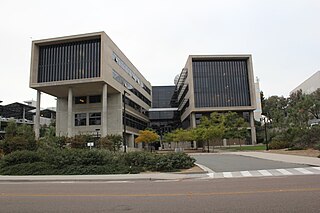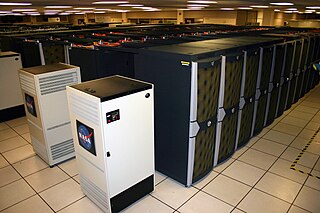
Silicon Graphics, Inc. was an American high-performance computing manufacturer, producing computer hardware and software. Founded in Mountain View, California in November 1981 by Jim Clark, its initial market was 3D graphics computer workstations, but its products, strategies and market positions developed significantly over time.

The San Diego Supercomputer Center (SDSC) is an organized research unit of the University of California, San Diego (UCSD). SDSC is located at the UCSD campus' Eleanor Roosevelt College east end, immediately north the Hopkins Parking Structure.

Columbia was a supercomputer built by Silicon Graphics (SGI) for the National Aeornautics and Space Administration (NASA), installed in 2004 at the NASA Advanced Supercomputing (NAS) facility located at Moffett Field in California. Named in honor of the crew who died in the Space Shuttle Columbia disaster, it increased NASA's supercomputing capacity ten-fold for the agency's science, aeronautics and exploration programs.

Altix is a line of server computers and supercomputers produced by Silicon Graphics, based on Intel processors. It succeeded the MIPS/IRIX-based Origin 3000 servers.

NorduGrid is a collaboration aiming at development, maintenance and support of the free Grid middleware, known as the Advanced Resource Connector (ARC).

Advanced Resource Connector (ARC) is a grid computing middleware introduced by NorduGrid. It provides a common interface for submission of computational tasks to different distributed computing systems and thus can enable grid infrastructures of varying size and complexity. The set of services and utilities providing the interface is known as ARC Computing Element (ARC-CE). ARC-CE functionality includes data staging and caching, developed in order to support data-intensive distributed computing. ARC is an open source software distributed under the Apache License 2.0.
The Oak Ridge Leadership Computing Facility (OLCF), formerly the National Leadership Computing Facility, is a designated user facility operated by Oak Ridge National Laboratory and the Department of Energy. It contains several supercomputers, the largest of which is an IBM OLCF-4 named Summit, which was ranked 1st on the TOP500 list of world's fastest supercomputers as of June 2018. It is located in Oak Ridge, Tennessee.
Research Computing Services, provides the focus for the University of Manchester's activities in supercomputing or high-performance computing, grid computing or e-science and computational science. Research Computing Services activities include services, training and research & development.
The Nordic Data Grid Facility, or NDGF, is a common e-Science infrastructure provided by the Nordic countries for scientific computing and data storage. It is the first and so far only internationally distributed WLCG Tier1 center, providing computing and storage services to experiments at CERN.
The Research Council of Norway is a Norwegian government agency responsible for awarding grants for research as well as promoting research and science. It also advises the Government in matters related to research, and is subordinate to the Norwegian Ministry of Education and Research. The council's total budget in 2009 amounted to NOK 6 165 million.

Pleiades is a petascale supercomputer housed at the NASA Advanced Supercomputing (NAS) facility at NASA Ames Research Center located at Moffett Field near Mountain View, California. It is maintained by NASA and partners Hewlett Packard Enterprise and Intel.
The Victorian Partnership for Advanced Computing (VPAC) was a leading, independent Advanced Computing R&D service provider and not for profit research agency established in 2000 by a consortium of Victorian Universities: Deakin University, La Trobe University, Monash University, RMIT University, Swinburne University of Technology, The University of Melbourne, University of Ballarat, Victoria University.
The National Institute for Computational Sciences (NICS) is funded by the National Science Foundation and managed by the University of Tennessee. NICS was home to Kraken, the most powerful computer in the world managed by academia. The NICS petascale scientific computing environment is housed at Oak Ridge National Laboratory (ORNL), home to the world's most powerful computing complex. The mission of NICS, a member of the Extreme Science and Engineering Discovery Environment, is to enable the scientific discoveries of researchers nationwide by providing leading-edge computational resources, together with support for their effective use, and leveraging extensive partnership opportunities.
The Vayu computer cluster, was the predecessor of Raijin, the Current Peak System of the Australian National Computational Infrastructure, located at the Australian National University in Canberra, Australian Capital Territory. It was based on a Sun Microsystems Sun Constellation System. The Vayu system was taken from Sun's code name for the compute blade within the system. Vayu is a [Hindu] god], the name meaning "wind". The cluster was officially launched on 2009-11-16 by the Government of Australia's Minister for Innovation, Industry, Science and Research, Senator Kim Carr,[2] after provisional acceptance on 2009-09-18.[3]

The National Computer Center for Higher Education (CINES), based in Montpellier, is a public institution of French administrative character placed under the supervision of the Ministry of Research and Innovation (MESRI), and created by decree in 1999.

Several centers for supercomputing exist across Europe, and distributed access to them is coordinated by European initiatives to facilitate high-performance computing. One such initiative, the HPC Europa project, fits within the Distributed European Infrastructure for Supercomputing Applications (DEISA), which was formed in 2002 as a consortium of eleven supercomputing centers from seven European countries. Operating within the CORDIS framework, HPC Europa aims to provide access to supercomputers across Europe.
Melbourne Bioinformatics is a high-performance computing cluster for life sciences and bioinformatics based in Melbourne, Victoria. It was funded by the Victorian Government and contributing institutions and hosted by the University of Melbourne. It operated under the name VLSCI from 2009 to 2016 before and was rebranded as Melbourne Bioinformatics in 2017.
iVEC was the government-supported high-performance computing national facility located in Perth, Western Australia. iVEC supported researchers in Western Australia and across Australia through the Pawsey Centre and resources across the partner facilities. iVEC was rebranded to the Pawsey Supercomputing Centre in December 2014.
The Pawsey Supercomputing Centre (PSC) is the government-supported high-performance computing national facility located in Perth, Western Australia. Pawsey supports researchers in Western Australia and across Australia through the Pawsey Centre (facility).
The Australian Geoscience Data Cube (AGDC) is an approach to storing, processing and analyzing large collections of earth observation data. The technology is designed to meet challenges of national interest by being agile and flexible with vast amounts of layered grid data.






